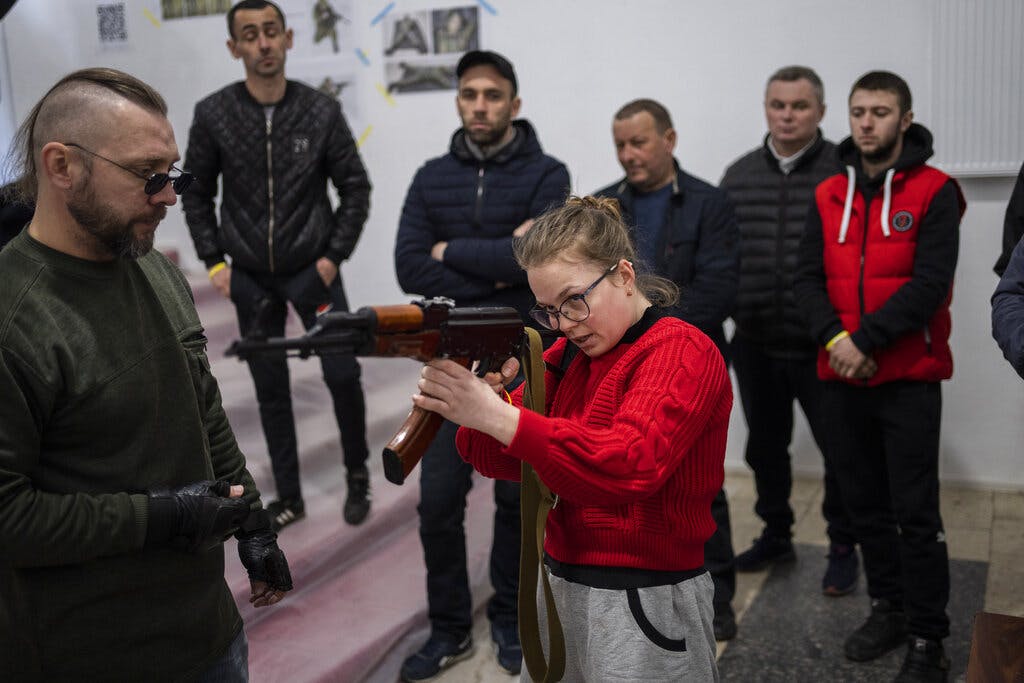Lviv Residents Steel Their City, and Themselves, Against a Russian Invasion
A military trainer compares Lviv to the Alamo, explaining that if Russian forces came to the city, the residents would fight “to the end.”

LVIV, Ukraine — By some measures, Lviv appears a city at peace. Grocery stores shelves are stocked daily for shoppers and selection is almost as diverse as before the latest Russian invasion began nearly a month ago.
While the war against Russia is largely confined to the country’s east, south, and capital areas, there are tell-tale signs that war has come to the country’s western region.
A missile barrage hit a regional airport outside Lviv last week. So far, though, the city has escaped the destruction suffered by cities like Sumy and Kharkiv in Ukraine’s east or Mariupol abutting the Sea of Azov.
Yet there are many outward signs in Lviv that the country is at war: sandbagged fighting positions are seen near government buildings, and armed soldiers protect important roads behind large concrete blocks.
Aside from the obvious physical preparations for war, there are more subtle indications that residents are steeling not only their streets against a Russian invasion but also themselves.
A dozen Lvivians filter through a nondescript beige building. Paint peels off the façade of the former school. A pair of volunteers standing just inside the entrance greet visitors and check their identification against a list of today’s participants.
They are here for a day-long training. Inside the school, they develop skills needed for fighting the Russians: emergency medical aid, firearms handling, and basic military training and tactics.
From upstairs, the metallic clang of moving rifle parts reverberates. Here, a group of 40 are arrayed in a semicircle around an instructor, a Ukrainian volunteer with military experience.
They’ve just completed the theoretical part of their firearm training, covering handling safety and shooting basics. The group is diverse — middle-age men hold a thin majority, but their ranks swell with the inclusion of teenage boys and several older women and some in their 20s.
Two rifles lie on the table behind the instructor. They’re AKMs, outwardly similar to the iconic AK-47 but optimized for mass production. The old weapons are serviceable — Russia’s most well-known gunsmith, Mikhail Kalashnikov, designed the AKM in 1959.
The instructor shows the group how to hold a rifle while walking — in front of the chest, don’t put the butt under your armpit, don’t finger the trigger, and keep the barrel pointed away from you and your comrades’ feet, he explains.
Safety is the no. 1 priority. With the rifles on safe and after visually confirming that their chambers are empty, the wartime students practice changing magazines, pulling their rifle’s charging handle, and dry firing.
They don’t use live ammunition or blanks, so the instructor grasps the ends of the barrels and jolts the rifles into students’ shoulders as they pull the triggers. “Bam! Bam! Bam!” he shouts, acclimating the students to the noise and recoil of a three-round burst.
During the training, Diana Korchak keeps a weather eye on the instructor. The 25-year-old student doesn’t have experience with firearms but is eager to familiarize herself with the basics of loading, aiming, and firing a rifle.
The rifle is heavy, and with her right hand on its grip, she struggles to pull back the charging handle with her left. The instructor tells her to jerk the handle back, not to be gentle.
With furrowed brow and a set jaw, Diana firmly tugs the handle back and releases — the rifle’s dull metallic click-clack makes her smile. She’s cocked the rifle. The instructor urges her to lean into it, and she pulls the trigger at a human-shaped paper target taped to the wall.
“Good,” the instructor nods, shoving the rifle into her shoulder. “Bam! Bam! Bam!” Although Ms. Korchak struggled to load her first magazine, the second run-through was much smoother.
The weapon handling didn’t go exactly as she wanted, Ms. Korchak explains. Her hands quiver from the adrenaline and excitement of holding the rifle. “I’m glad I can do this myself,” she says, breathlessly explaining that she might need to apply the knowledge from the day’s training “in the future.”
One of the training center’s administrators, 42-year-old Oleg Orekhovsky, is an entrepreneur during peacetime. According to the organization’s records, more than 2,500 city residents have completed the all-day course since it began in the first week of March.
He went through weapons training at the center too and feels better for it. The training “builds confidence and mental preparedness” in the civilian participants, many of whom have never handled a firearm.
On the school’s third floor, volunteers with medical experience teach participants basics like keeping the victim’s airway open and how to perform CPR. The express training also covers how to treat wartime wounds caused by bullets and shrapnel.
A tall, scruffy trainer says, “In an ideal situation, the victim will regain consciousness,” but “if he doesn’t…” he trails off, explaining how to stop the flow of blood from limbs.
Many of the center’s instructors are Ukrainian, though the facility also hosts a contingent of Finns, veterans who drive supplies into the city and impart their military knowledge to the eager Lvivians.
One of them, Gintautas Mauricas, is grizzly and bearded. He worked with young men and women, teaching survival and bushcraft techniques in the wilderness until recently.
He served both in Finland and Afghanistan during his 24 years of service. In Ukraine, he leverages his public affairs and military experience to train civilians, not to fight the Russians himself.
He explains that Ukraine is like Switzerland or America, and “lots of people have a rifle and ammunition at home.” For that reason, Mr. Mauricas “wouldn’t want to be a robber in Ukraine,” much less a Russian soldier.
With the Russian offensive to take Kiev stalled and military resources focused on cities in the southeast, Mr. Mauricas is skeptical about Russia’s prospects for and interest in taking Lviv.
He compared Lviv to the Alamo, explaining that if Russian forces came to the city, the residents would fight “to the end.”
Outside the school, the training participants mill about excitedly. Ms. Korchak says she was “a little bit nervous” because “everything is new for me.” After finishing the training she has more confidence.
“Every day I pray for peace in my free, independent country,” she explains. But if war does come to Lviv, “I hope I can be useful.”

